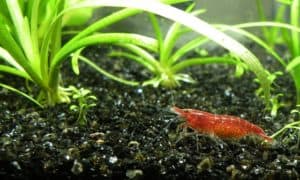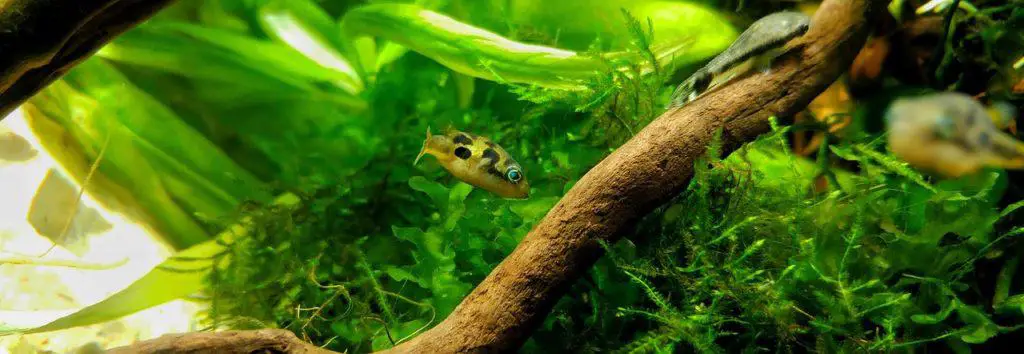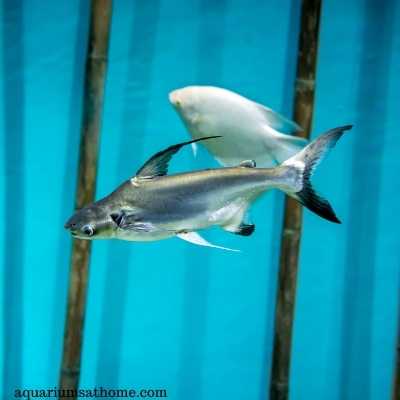Growing plants in your freshwater aquarium is not only beautiful, it creates a natural and healthy environment for your tanks inhabitants. Freshwater plants are fairly easy to grow and will thrive in your tank with minimal maintenance.
How to grow live plants in freshwater aquarium? Freshwater aquarium plants can be grown in gravel, sand or pots. With the proper substrate in place, growing plants in an aquarium is easy. Using proper fertilizers and planting in mini pots with soil might be required. This will depend on each plants specific needs and your choice of substrate. To grow plants in your freshwater aquarium you will also need proper lighting and a CO2 source.
It is easy to grow plants in your tank once you get the hang of it. You should understand the process of planting and growing as well as how the live plants affect the aquariums water parameters to be successful. In this article, I will explain how this all works to make sure you don’t waste your money buying plants that just end up dying. Your fish will love you after you add plants to the tank!
Are Plants Good for Fish Tanks?
Live plants are a smart choice for a freshwater aquarium. When thinking of freshwater fish living in their natural habitat, what objects do you find in the water with them? Rocks most likely and, most definitely, plants, branches and logs.
Some fish such as cichlids aren’t a great fit for a live planted tank as are some other species. These fish will uproot the plants and make a mess out of the tank. The good news is that 70% or higher of other freshwater fish species do great in planted tanks.
The only other types of fish you will want to stay away from are aquarium fish that eat live plants. Fortunately, your local fish store will be able to direct you to the right fish for your set-up. You can also browse this website for many ideas of what types of fish to stay away from with a planted tank.
How to Plant Aquarium Plants in Pots
If you want to contain your live plants roots then planting them in small pots is the way to go. You can use plastic pots or use a fabric pot. Fabric pots can be made easily if you decide to give that a try.
If your goal is to contain the roots then do not cut holes in the plastic or fabric as the roots will find the holes and quickly start to grow out of the pots.
Place the small pots with live plants planted into your substrate or between rocks and decorations, it’s that easy.
If you have organic potting soil for houseplants it can be used. Just make sure it is an organic mix with no additives. Or if you really want to make sure you use the proper soil then go for an aquatic plant potting soil. API and other manufacturers make soil for ponds that you can use in freshwater tanks for plants.
Check out different aquatic soils here on Amazon.
How to Grow Aquarium Plants in Gravel
Growing aquarium plants directly in substrate is becoming more and more popular. It’s just so easy to take a plant and place the roots into the gravel. It is such common practice now that you can purchase stainless steel aquarium planting tools like these ones, which will simplify and make the process much easier for you.
The process of planting live plants into your tanks gravel is easy. When you purchase live plants, take them out of the bag and water. Gently separate the roots, if possible. If you try to separate the roots and they don’t pull apart then they probably shouldn’t be separated. Most aquarium plants though should be able to be pulled apart so you can plant them.
Take the roots, gently placing them into the gravel, ensuring they are covered completely. Do not cover any of the plants leaves or branches itself. If you do, you might stunt its growth. That’s basically it for planting into gravel. The roots will start to grow throughout the gravel. Just remember, when you vacuum the bottom of the tank, there are roots living underneath the substrate.
How to Plant Aquarium Plants in Sand
One of the main issues you might run into when planting plants in sand is getting the proper nutrients to the plants roots or leaves. Some plants absorb fertilizer (nutrients) through their roots where others can gather nutrients from the leaves of the plant. Sand probably won’t hold nutrients in as well as other substrates like soil or mineral rich volcanic soil like the Fluval Stratum brand which is made specifically with live plants in mind.
- First off, when planting plants in sand make sure the roots are covered well. In some cases, you might need to use decorations or other items to help keep the plants in place until the roots start to take off and gather some length. At that point, the plant will not require any help keeping rooted.
- Using root tabs for plants that absorb fertilizer mainly form their roots is a smart idea. This will ensure there is a steady source of nutrients as the plants need it. Seachem manufactures time released tabs that work very well with plants planted into a sand substrate. Check them out on Amazon. Flourish tabs for live freshwater plants.
- Plants that prefer absorbing fertilizer through its leaves are a fine choice for a sand based tank. If you need liquid fertilizer there are many different brands available.
Best Substrate for Planted Aquarium
When thinking about what the best substrate would be for a planted tank I consider a couple of things.
- The roots of the plants need to be able to grow and thrive with zero to minimal restriction. This means the substrate should not be able to pack down too much. The substrate should be able to hold plants in place as they grow as well as allowing pockets of space where the roots can grow.
Traditional aquarium gravels can work just fine, however, there are other products manufactured that look like gravel yet are lighter and will allow the roots to move. One of the products I really enjoy using is Fluval Stratum. This product is a volcanic soil and is lighter than regular gravel. This means the roots will grow freely without restriction.
- The other very important thing I consider when selecting a substrate for planting aquarium plants is will the substrate provide and nutritional value to the plants. This means the plants will get all the help they need to start them growing as soon as possible.
Does the substrate provide key nutrients to promote rooting to take place as quickly as possible? Again Fluval Stratum fits the bill because of its naturally nutrient dense properties. Now that being said, after a couple months, you should still also use a good fertilizer for general tank maintenance.
Proper Lighting and CO2 are required to Grow Plants in your Freshwater Aquarium
Aside from fertilizer and healthy water, two other factors can affect the success you have trying to grow live plants in your tank.
- One important factor is lighting. As with all living plants, whether on the ground or in water, light is usually required to promote growth. If you purchased an aquarium kit, the lighting you have might not be adequate for proper plant growth. That being said, most new kits are now better equipped with proper lighting for fish and plant needs.
You also have the option of purchasing new lighting for your tank even if you already have lights.
Another option would be to do some research and see what aquarium plants will thrive in most lighting conditions. For some great lighting options or for ideas on what is available check out my recommended lighting page here.
- Getting oxygen into the tanks water is crucial to healthy aquarium water as well as healthy fish and plants. To have oxygen enter the water naturally occurs at the surface of the water. To really get a good understanding of how this works check out my article on whether air pumps are necessary or not. I explain how oxygen enters water. Are air pumps necessary in an aquarium?
- You might not want an air pump running and I can understand that as well. Some older models can be quite loud. You could try placing the pump in the aquarium cabinet if you have one. Another idea I like is to build a box out of rigid insulation and place the pump in that. It would muffle the sound quite well.
- If you want to know another way to get oxygen in the water, you could use a product that is a liquid CO2. This can be used in place of doing it naturally. If at all possible, I would always recommend agitating the water’s surface allowing the oxygen to enter naturally.
- Using CO2 tanks is another option that will work and is highly promoted in some communities. I would only go this route if you are planning on filling up a very large tank with plants. Otherwise, save your money and focus more on surface area agitation with maybe adding liquid CO2 once in a while.
How to Grow Aquarium Grass [tips]
Growing aquarium carpet grass can be super fun and will really add the wow factor visually for your tank. There are many options when planting grass in your tank. A couple options for you to try are Dwarf Sag and dwarf chain swords. These are excellent selections for beginners as they are a couple of the easier varieties to grow. The selection you have may be different at your local fish store, however, you could always order aquarium grass online.
- These varieties can be grown without adding CO2 as they are very hardy and will grow in most conditions.
- When planting aquarium grass, separate the roots as best you can and when planting, keep each section you plant a few inches from each other. This will allow the runners to grow and spread out which means more growth on top of the substrate as well. Over time, all of the areas without plant will start to fill in.
- When growing plants that are low profile, like an aquarium grass, make sure there are nutrients in the substrate for the roots to absorb. Using a substrate like Fuval Stratum is a good choice as well there are many other options available on the market.
- If you find your grass really starting to stretch out and grow longer than you think it should be, then you probably need a stronger light. If plants don’t get adequate lighting in an aquarium, they will stretch out to reach the light. It is self-preservation at its best.

How to Grow Aquarium Plants from Seed
Can you grow aquarium plants from seeds like you would in your garden? Yes, you can grow aquarium plants from seed. Assuming you have the seeds you want to plant you will also need a small container to plant the seeds in and some aquatic soil.
I recommend aquatic soil because once the plant is growing it will make the transition into your tank much easier and with a greater success rate.
- First place aquatic soil in a container (an organic planting soil can be used if it has zero added nutrients).
- Add your aquarium plant seeds to the top of the soil and wet with a spray bottle or if you can water without having all of the seeds group together in a clump.
- Keep the seeds and soil moist at all times.
- You could place the container in a tray that contains water and if the container with soil has holes in it the water will constantly feed the soil.
- Once the seeds have sprouted for a few days start adding aquarium water to the container submerging the plants over a couple of days.
- After a week the plants can be transplanted into your aquarium.
That’s i!. It is a very simple process that anyone can do. If you stock seeds at your home you will save yourself some money and will always be able to fill your tank with beautiful plants.
How do Aquarium Plants Affect PH?
This is really important to know now that you want to grow live plants in your aquarium. Plants will definitely affect the PH and alkalinity in your tank. This answer is much bigger than what I will give you hear but if you want to learn more about alkalinity in your tank please go and read that article after you are done here.
A high level answer would be that plants absorb carbon dioxide in the water which is great news. When plants absorb carbon dioxide PH will rise in the water. Plants also absorb ammonia, this keeps the PH from dropping.
Some aquarium plants will absorb minerals with the result being lower PH levels.
Overall though, when you have decaying food, fish waste, growing plants and fish in a tank the PH for the most part will be at a good level for all living things in the tank.
It is recommended that you find out how each plant you select to own will affect the water parameters and what special nutritional requirements they might have.
Where to Place Live Plants in Tank?
Now that you are ready to grow live plants in your tank, where do you put them? Of course you can place them anywhere you please. You should consider a few things when placing the plants in your tank.
- Plants can be used to cover tubing and other pieces in the tank you really don’t want to see. So use appropriate sized plants in these areas.
- Make sure the plants will not block to much light. If light is blocked it will hinder plant growth and could affect the health of the fish.
- Keep think wavy plants away from filter intakes and other pieces that could suck in the plant wrecking them and plugging up pieces of equipment.
- Use plants in a way that they will provide shelter for fish. This will help your fish feel safe and happier.
- Last, but not least, have fun with it. What you create in your tank is only limited to your imagination.
You should now be confident in trying to grow some live plants in your freshwater aquarium. Just remember to take your time and come back here for help if you need it. Good luck with your aquarium.
Related Aquariums at Home Articles
DIY Aquarium Plant Cleaning: Save Money & Keep Your Tank Pristine
Can You Put Bamboo Plants in an Aquarium?






